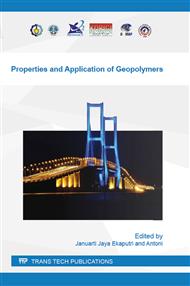p.72
p.79
p.83
p.90
p.98
p.104
p.111
p.118
p.126
Compressive Strength of Geopolymer Based on the Fly Ash Variation
Abstract:
. This study was conducted to determine the factors that may affect the compressive strength of fly ash-based geopolyme, manufactured using fly ash obtained from different power plants. Fly ash obtained from different sources may have very different characteristics that affect the properties of geopolymer product. The source of variations in the geopolymer properties from the view point of the source materials can be classified into internal and external factors. Internal factors include the physical and chemical properties of the fly ash, while external factors associated with mixture proportion of geopolymer and the manufacturing process. From the experimental results, it was found that the size of the fly ash granules, the CaO and MgO content, and the carbon content in fly ash are the internal factors that may affect the compressive strength of geopolymer. On the other hand, the ratio of sodium silicate to sodium hydroxide in the alkaline solution and the molarity of the sodium hydroxide solution are the external factors influencing the compressive strength of geopolymer.
Info:
Periodical:
Pages:
98-103
Citation:
Online since:
January 2016
Authors:
Keywords:
Price:
Сopyright:
© 2016 Trans Tech Publications Ltd. All Rights Reserved
Share:
Citation:


